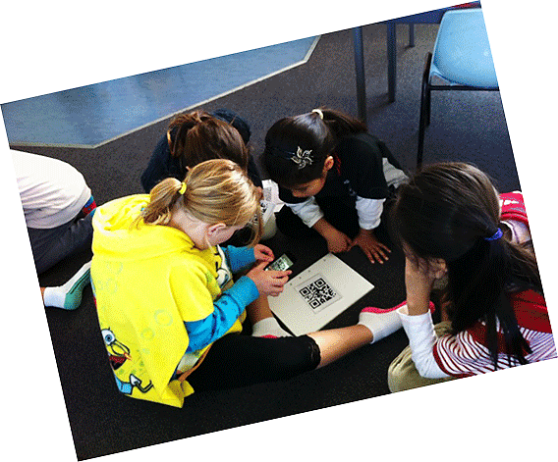(Coutts, 2011)
Tasks that integrate QR codes and/or referenced learning spaces provide students the opportunity to build their knowledge and understanding in a learner-centred constructivist environment compared to the traditional teaching environments which are teacher directed. (Prestridge, 2011) This is a valued learning environment as “students create knowledge in the digital era through connections in an open and flexible curriculum, rather than the teacher transmitting the ‘trust’ and methodologies of a subject”. (Starkey, 2010, p. 242)
In this constructivist environment, the learning is designed to be on par with the creating and sharing knowledge level outlined in Starkey’s digital learning matrix. (Starkey, 2010) Within the sharing knowledge level, the learning is focused towards presenting the information and the students engaging in and sharing their knowledge with others. This can be completed in many different environments with for example the QR code leading to a blog which can be an appropriate format for the children to continue accessing and sharing knowledge with each other in the local and global community. When analysing Starkey’s matrix, it is seen that the students need to be provided opportunities to access information, present and process information, use interactive programs and communicate using digital technologies. (Starkey, 2008) By using referenced learning spaces students initiate the digital learning by viewing and processing information, creating their own conceptual understanding as well as allowing an opportunity for them to enhance their knowledge on different materials, motivations and ideas.
Through authentic problem based collaborative learning activities, ICT’s can be used to construct knowledge in the classroom. (Prestridge, 2011) Referenced learning spaces such as QR codes allow this integration to occur. These spaces can lead to learning environments that give students the chance to express their findings and understandings, provide their research and communicate and co-construct ideas with others, allowing them the chance to relate it to real life practices. (Prestridge, 2011) Teachers can create these learning activities so that they incorporate the general capabilities for ICT outlined within the Australian curriculum; inquiring, creating, communicating, operating and looking at ethical issues (ACARA, 2010)
ICT’s have become an integral part of day to day living within the 21st century, from how we communicate, share and co-construct with members of the global community. ICT’s are embraced outside of the school community and seen as a necessary tool in the world we are preparing our students for; therefore we must embrace them and make them a necessary teaching and learning tool within the classroom. QR codes and referenced learning spaces provide an opportunity for students take a hold of the opportunities that the digital era and technology have made available to them with access to information and ideas as well as people from a wide range of sources within the global community at any given time; (Starkey, 2008) therefore making the digital classroom a reality for the students of tomorrow. These learning activities have a student centred focus that allows both the teacher and learner the chance to use strategies that encompasses digital recourses and technologies. (Prestridge, 2011)
Week 3 Reference List:
ACARA Australian Curriculum, Assessment and Reporting Authority. (n.d.). The Australian curriculum: Information and Communication Technology (ICT) capabilities. Retrieved on 14th March, 2013 from http://www.australiancurriculum.edu.au/GeneralCapabilities/Information-and-Communication-Technology-capability/Organising-elements/Organising-elements
Coutts, T. (2011) The CORE Education Blog. Exploring QR Codes with Children. Retrieved from http://blog.core-ed.org/blog/2011/10/exploring-qr-codes-with-children.html
Prestridge, S. (2011) Computers and Education. The beliefs behind the teacher that influences their practices. Pgs.449-458. Doi:10.1016/j.compedu.2011.08.028
Starkey, L. (2008) Evaluating learning in classroom activities using digital technologies. Paper presented at ACEC 2008, Canberra.
Starkey, L (2010) Teachers and Teaching: Theory and Practice. Teachers’ pedagogical reasoning and action in the digital age. pgs.233-234. Doi:10.1080/13540600903478433

